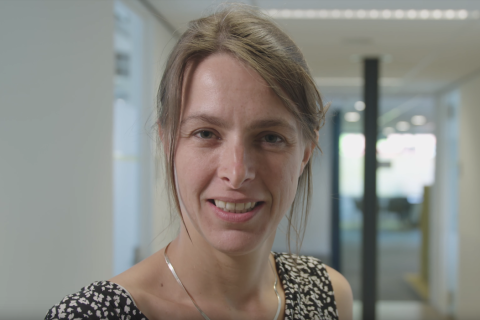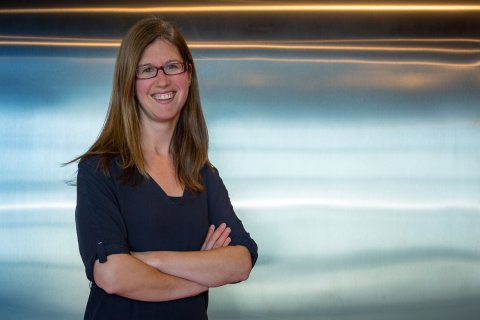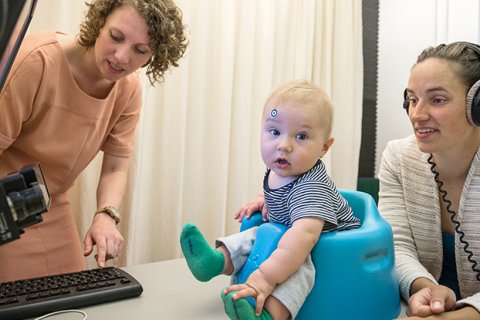Building a coordinating view of child development
Caroline Junge and Carlijn van den Boomen on project SAPIENS
Caroline Junge and Carlijn van den Boomen study the development of baby brains at the Faculty of Social and Behavioural Sciences. As of next year, they will get to work on the recently approved EU-project SAPIENS (ShAPIng the social brain through Early interactioNS) together with an international group of researchers. Van den Boomen says: "We want to learn to better understand the interaction between young children and their parents."

How do young children control the interaction with their parents? And how can you actually measure that? The interdisciplinary European project SAPIENS asks these questions. Caroline Junge, one of the involved researchers, explains: "We document what children do exactly in the interaction with their parents. Like how and when do they laugh, and how do their parents respond to that? We still know relatively little of the active role the child plays. We have looked before at how children respond to seeing certain stimuli, but not how they - consciously or unconsciously - control the interaction with their parents."
Her colleague Carlijn van den Boomen adds to that: "Parents are the primary contacts to babies and very young children. We then look at how that interaction further influences your social development." Junge says: "We do that with normally developed children as well as certain subgroups. Especially babies at risk of autism."

SAPIENS hopes to develop new methods in order to better study the role of the child. Junge says: "For instance, I look at the connection between social development and language development, and our colleague Roy Hessels is going to look at parent-child interaction with dual-eye tracking. Besides that, we also hope to get a better set of diagnostic criteria in the future." Van den Boomen says: "With the help of algorithms that show which roles and differences there are in social interactions, you can develop diagnostic tools for developmental disorders that show themselves during the baby time. Think of autism and ADHD."
One step at a time
SAPIENS continues to build on three earlier big, interdisciplinary EU collaborations, the first of which started about 10 years ago with the goal to unite researchers from several countries. The focus is always on early child development, although the point of attention shifts with every project. Junge says: "The projects always have unique goals. And the current one is: to develop new methods to document interaction."
SAPIENS also wants to build a bridge between science and (clinical) practice.
"Development doesn't always have to be stable, and the fact that you can look at it in different ways can result in you working in a fragmented way," Junge continues. "With these projects, we are actually building a coordinating, interdisciplinary look." Many disciplines are involved in this project, after all. Van den Boomen says: "We look at brains, behaviour, genetics, others look at the technical side: how can you measure and analyse real-life brain activity, and develop algorithms?"
SAPIENS also wants to build a bridge between science and (clinical) practice. Van den Boomen says: "On the clinical side, there are people who know a lot about diagnostics of autism or ADHD. How do parents look at that, which questions do they face? Another part that's important to the EU is the collaboration with different types of companies. These companies include a company that trains and guides parents in childrearing, and there are companies that develop techniques such as eye tracking or do EEG analyses."

Investing in young talent
In September 2019, two (international) PhD Candidates get to work for SAPIENS in Utrecht. A total of 15 teaching assistants from universities all over the EU will collaborate on the project. Junge says: "This EU network focuses on young, beginning researchers. It's about improving their research skills and the promotion of networks between universities."
Carlijn van den Boomen coordinates the training of the 15 SAPIENS PhD Candidates. "They'll see each other twice a year for a week, always at different places so they'll see a different lab every time. That can be in Rome, London, Warschau, Gent or Uppsala. And throughout the year, they'll help each other with each other's projects. With tools co-developed here by Educate-IT, we let them give intermediate online feedback."
PhD Candidates have to learn to organise, present, talk to people and discuss.
This means that the young researchers will not go through a standard PhD track. Van den Boomen says: "After the project is over, these young people will have to be ready to become researchers, or work in the corporate world or at NGOs. So they are being prepared on a broad scale. They have to learn to organise, present, talk to people and discuss. We're going to explicitly focus on that."
By the way, there was also something to learn for young researchers who already had their PhDs. Van den Boomen says: "The applications for the previous EU projects were written by professors. This time, they said that the next generation would have to do it. They did supervise us and gave us feedback, but they also gave us the chance to use this network and gain experience in how to write these kinds of applications."
Research Theme Youth
If you want to tackle social problems, it would be best to start with children. The Utrecht-based research theme Dynamics of Youth invests in a resilient youth. Academics from all fields collaborate in order to learn to better understand child development. How can we help children and youngsters to grow and flourish in our rapidly changing society?

